The Lepontic alphabet is the form of written communication adopted by Cisalpine Celts from the 6th century BCE until the 1st century CE and, given its distinctive handwriting, is considered the first ever Continenal Celtic alphabet. Of clear Etruscan inspiration thanks to the contact between the Golaseccha culture and the Etruscan society of the 7th century BCE, its use clearly identifies both its socio-cultural value and its need that was created in the period preceding its coining and makes the society uniquely cisalpine precisely in the function of the possession of a writing in continuity with the local tradition being ancient, ideologically representative and connoted.
The existence of this alphabet does not, however, indicate the sclerosis of social and spiritual doctrine: in Celtic culture, writing was delegated to the world of commerce and light communication, often using the Greek language to make the written word comprehensible even externally; another use was linked to spirituality, worship and learning, since the Celts gave oral transmission an importance born from the need to control information (since in druidic doctrines such as herbal medicine or the sciences it was essential that the knowledge did not fall into the wrong hands) and from the well-founded belief that what was written became cold, immobile and unable to carry within itself the true value of the word once it became engraved.
Ornavasso: the spinning top flask

laTumarui : saPsuTai : Pe : uinom : našom
“For Latumaros and Sapsuta, wine from Naxos”
This inscription, engraved on a head flask-type wine vase, comes from tomb 84 in the necropolis of Ornavasso (VB) and is dated to the end of the 2nd and the beginning of the 1st century BCE.
The short sentence presents the names of two dedicatarii in the dative case - one masculine, one feminine -, connected through the conjunction -pe (equivalent to the Latin -que), followed finally by a nominal phrase. Latumaros and Sapsuta are the two proper names: Sapsuta does not seem Celtic, but is declined in the Celtic way while Latumaros would contain a recognisable Celtic element -maros 'big' common in personal names, as well as a root attributable to the Gallic side meaning "ardor, fury"; uinom is clearly the term for "wine" and Našom is the adjective indicating the Greek city of Naxos in Sicily, famous for its fine wine.
The Prestino stele

uvamoKozis : Plialeθu : uvlTiauioPos : ariuonePos : siTeś : TeTu
"Uamokozis Blialedu has placed (this) stele for the Uvltiauio- Ariuo-"
Found by chance in Prestino (CO) in 1966 during the construction of a highway, this sandstone stele is almost four metres in length and was the first discovery of a probably public or sacred complex dating back to 480-450 BCE.
The inscription is considered by many to be the oldest known in a Celtic language (6th-5th century BCE) and known also for its particularity of reporting a verbal element and three unusual signs (θ, v and z) in Lepontic.
The structure can be analysed as follows: the double name of the dedicator in the nominative, followed by the double name of the dedicatee in the plural dative (-bos), the object of the dedication in the accusative, and finally the verb. The inscription shows an order of the elements of the archaic sentence type Subject-Object-Verb, while another inscription coming from Vergiate demonstrates rather the order Subject-Verb-Object. It is therefore assumed that Lepontic was slowly evolving from the archaic type towards the newer one.
The funerary stele of Vergiate
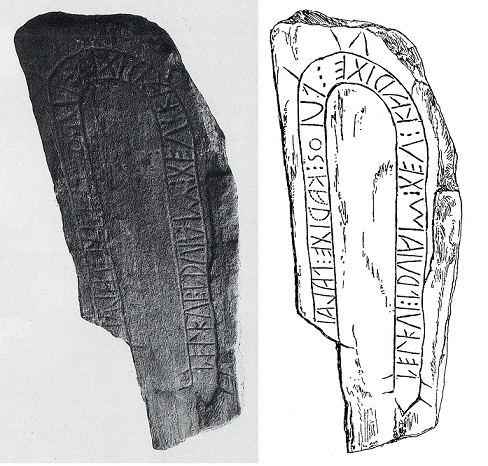
pelkui : pruiam : teu : karite : iṣ́ọs : kalite : palaṃ[
"Deu placed (?) the tomb (?) for Belgos ; he himself erected the stele"
The inscription clearly shows a two-sentence structure, containing two verbs in the past tense (karite, kalite) and two objects in the accusative singular (pruiam, palaṃ). The analysis and translation, although uncertain, can be summarised as follows: the first term appears to be in the dative singular indicating the name of the beneficiary of the offer, followed by the dedicated subject, while the dedicator himself would be teu. Iṣ́ọs would be the demonstrative pronoun in the nominative. Regarding the two objects, pala could be translated as "stele", already known through other inscriptions and always in a funerary context. The interpretation of pruia, on the other hand, is more difficult, with some scholars having compared it to the Gallic term briua 'bridge, pavement'.
The stele of Castelletto Ticino (NO)
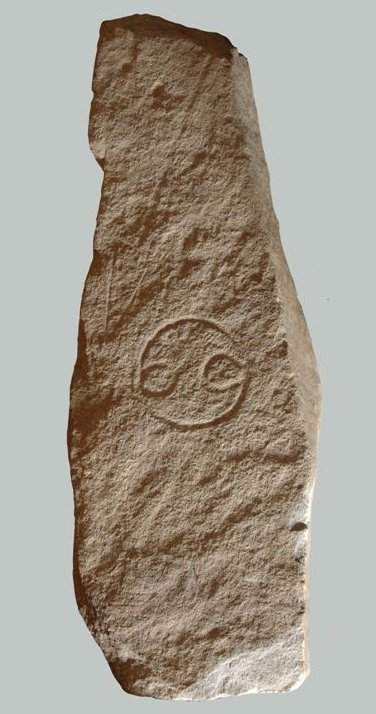
The stele of Briccola di Castelletto Ticino is the only large figured stele (that is, with recognisable and not exclusively symbolic elements such as cupels) so far known in the Golasecca culture and has unique characters in the Italian context. It is a large stele with a wide base that narrows towards the tip with slightly oblique sides and the alteration line of the original burial point is clearly recognisable, about twenty centimetres from the bottom. A pair of cupels are recognisable on the rear face, while on the front face there are several engraving phases with complex figures. The most recent phase shows at about half-height the precise and deep lithic hammer yield of an Italic Mozzano-type kardiophylax, represented horizontally and without oblique attacks. This seems to be associated with a spear placed obliquely in the upper part with a large triangular tip with thin and deep edges facing downwards: the spear seems to overlap at least some of the dozen cups present on the upper half of the stele (plus one preserved immediately above the burial line).
The stele of Vercelli

Latin: finis campo quem dedit Acisius Argantocomaterecus com<m>unem deis et hominibus ita uti lapide[s] IIII statuti sunt.
Celtic: Akisios arkatoko<k>materekos tošo kote atom tevoχ tom koneu
Found during excavations in 1960 in a riverbed of the Sesia river near Vercelli, about 350 metres south of the railway bridge that crosses the river, it was kept for years in a condominium courtyard and in 1967 transferred to the Leone Museum of Vercelli where it is still preserved.
Two texts are engraved on the front side of the stone: the upper part is in Latin, the lower one in Celtic, both right-handed. The first consists of eight lines while the second only four, the last word is marked by a horizontal line so as to close the epigraphic space. The letters are rigidly traced and are characterised by deep engravings. The shapes of the letters do not have archaic characteristics. Some characters have ligatures and all words except the first are interspersed with circular dots. The Celtic text, on the other hand, is written in the northern Etruscan alphabet of Lugano and does not have the same characteristics as the Latin one. Although here too the words are divided by points, the stonemason did not place the same clarity in the subdivision. It is not clear whether the Celtic text is smaller since it is considered a brief summary of the Latin one for those who still did not understand the language of the Romans, or reported out of respect and scruple of the indigenous religious tradition. It is possible to read this difference in the light of the fact that since these spaces are very widespread in Celtic culture, a comment or explanation was not necessary and which therefore only interested the Latin people to whom this practice was unknown. Another hypothesis is that the message of the monument is defined for the Celtic context in an ostentatious perspective of the status of the Roman Acisius who, having acquired Roman citizenship, wanted to underline the new character of Roman-style city life.
The inscription of S. Bernardino di Brio
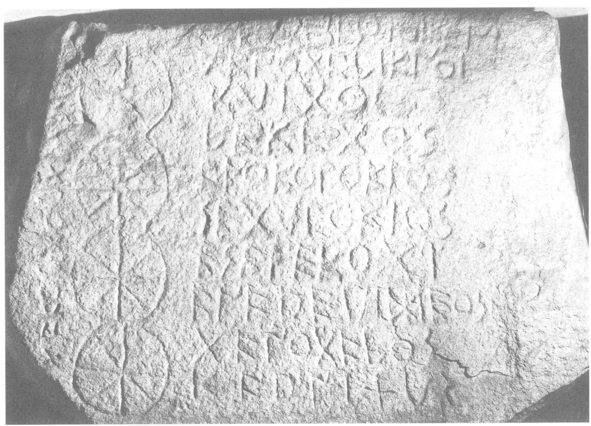
nạkọ tesasopoikam / tanotaliknoi / kuitos / lekatos / anokopokios / setupokios / esanekoti / anareuišeos / tanotalus karnitus / takos.toutas.aus
Dannotalos’s sons, Quinto, Legato, Annocombogio, Setubogio [and] Esannecottios’s sons, Anareuišeos, Dannotalos erected
The stele, discovered in 1859, comes from the area where the church of San Zenone stood in the moorland of S. Bernardino. The place is located a few hundred metres from a Golasecchian necropolis with tumuli of the 6th-5th century BCE. The inscription whose reading is still discussed above all with regard to the first and last line (underlined above) is arranged in two main segments: the first consisting of nine lines is made with one word per line, very carefully written and with deep and detached signs. The second, consisting of a transverse line and the first being horizontal, is organized with smaller letters in the spaces left free by the main text with irregular edges and without scanned words. In the easy interpretation of the first part of the text, the use of the typically Lepontic patronymic -iknos stands out, while the following segment is difficult to interpret: in it the first two words can be separated, Tangos Toutas, interpreted as iudes (or dictator, depending on whether its nature is civil or military) and civitatis (even if the word toutas has a more ethnic and less urban sense than civitatis). The rest of the writing is impossible to translate because it is illegible. However, it can be assumed that the missing lemma is a verb or another expression of action to perhaps testify the dedication made to or by the magistrate.
The funerary stele of Buca
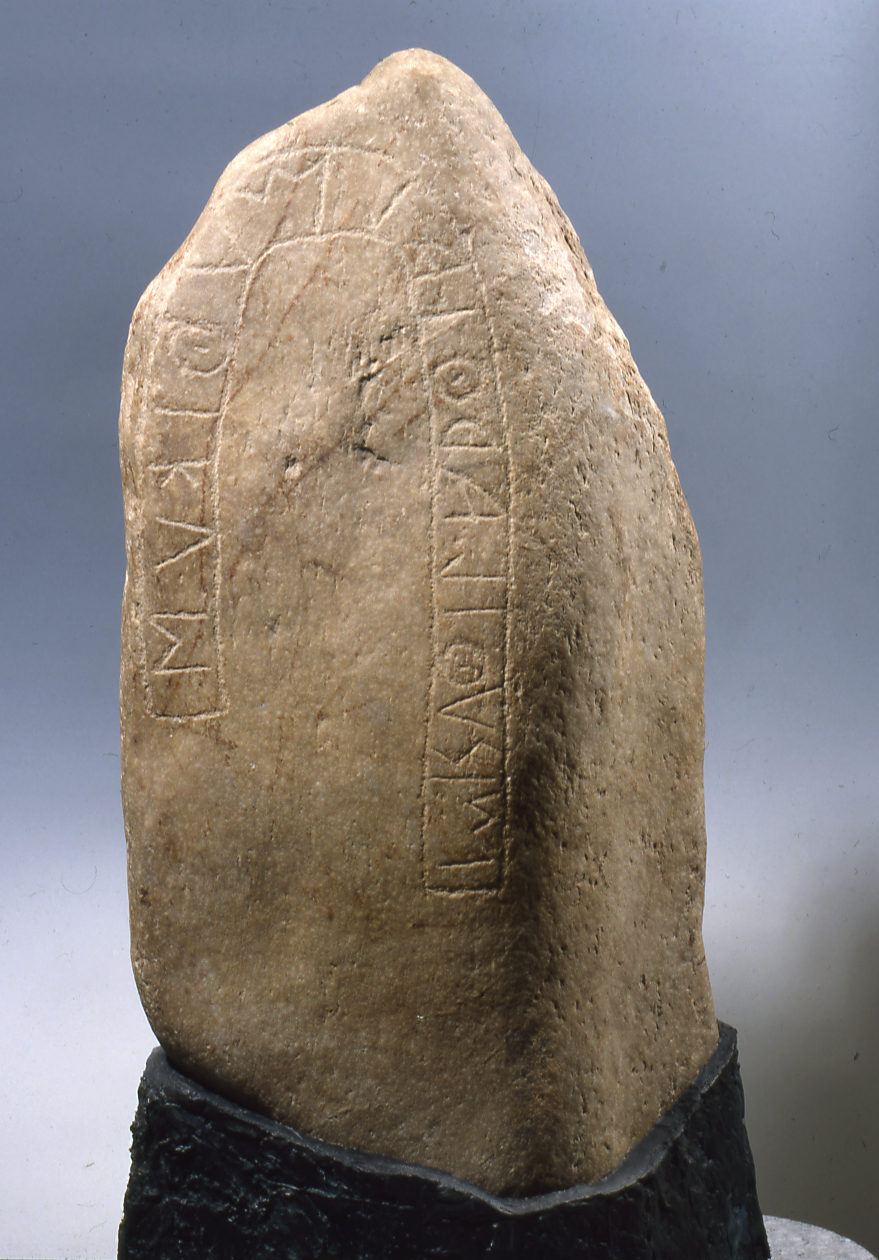
Mi suði larðial muðikum
I (am) Larth Muthiku’s tomb
The exceptional funerary stele from Busca (CN) is carved on a boulder of certainly local quartzite: on one side within two guidelines the inscription is engraved and arranged in an upside-down U-shaped ribbon from right to left and from bottom to top.
The text is written in the Northern Etruscan alphabet and in the Etruscan language, but the origin of the name of the deceased (Motico) is Celtic-Ligurian, albeit Etruscan in its declination. The layout of the inscription is also typically Etruscan, in particular from the Volterra area.
The find is particularly significant in representing the adoption of the Etruscan cultural model by the local Celto-Ligurian elites, probably engaged in trade in small emporium centres along the river routes. That the Ligurian Motico had actually lived at least for a few years in the Etruscan Volterra or in a centre culturally dependent on it, thus adopting its funerary and name-day customs or that he only intended to emulate them from afar, it is certain that the customs represented the dominant model of prestige also for the members of his community at the foot of the Cuneo Alps, inside which he was buried with this stele that was probably placed as a marker on the tomb.
The discovery took place in the 18th century and, therefore, the original context of its position is unfortunately not known.
Trinvxtion Samoni Sindivos
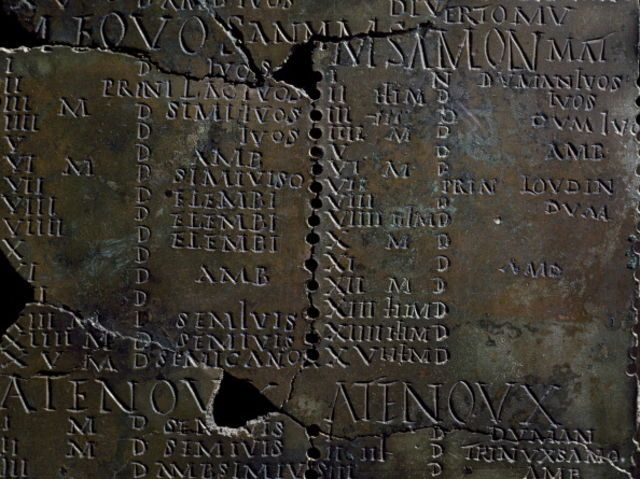
Coligny calendar
The discovery of the unique Coligny calendar made it possible to realise not only the extent of the astronomical competence of Celtic society, but also to shed light on the holidays that were celebrated, creating a clear division between the Sabbats of neo-culture, druidic, children of the Celtic Renaissance on the one hand and the historical reconstruction of the La Téne period on the other: the 30-day-long month of Samonios presents the second fortnight divided from the first by the Gallic word ATENOVX 'return to the dark, renewal' and the second day after ATENOVX corresponds to the celebration of Trinuxtion Samoni and the abbreviated Gaulish term TRINVXSAMO corresponds to the Gaulish phrase Trinvxtion Samoni Sindivos which translates as "the three nights of Samonios begin now". This annotation refers to the most important festival during the Celtic year which marked the beginning of the winter season and also of the year.
A further peculiarity of the calendar is the use of the abbreviations M (matv 'lucky') and ABM (ambilis 'inauspicious') to indicate a few days considered auspicious or inauspicious based on the spiritual knowledge of the time.

